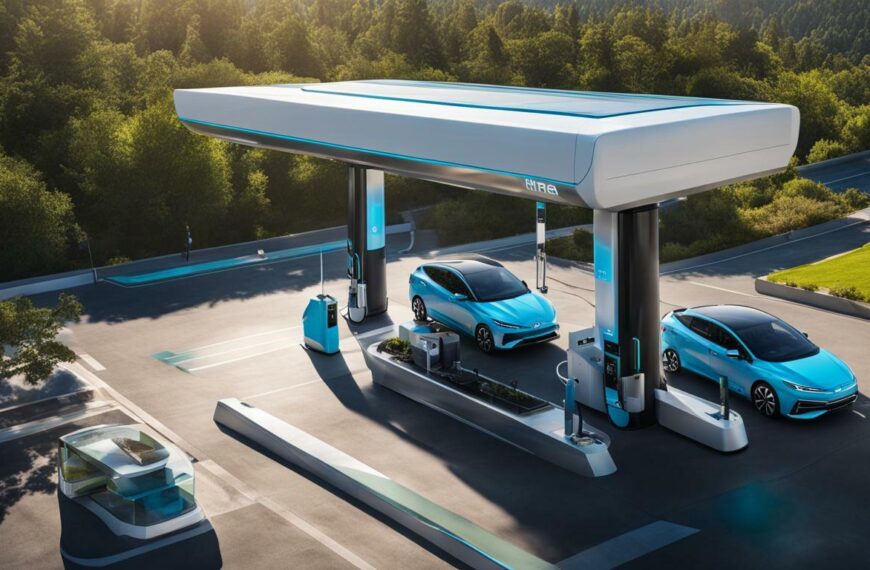Green hydrogen is a promising alternative fuel that has the potential to transform the way we power our vehicles and combat climate change. As the world strives for cleaner and more sustainable transportation options, green hydrogen emerges as a frontrunner in the race towards zero-emission vehicles.
Produced through the process of electrolysis, green hydrogen is derived from renewable energy sources such as wind, solar, or hydroelectric power. Its production involves splitting water molecules into hydrogen and oxygen, releasing only water vapor as a byproduct. With this clean fuel, fuel cell vehicles can operate without emitting any harmful pollutants or greenhouse gases, making them an attractive solution for sustainable transportation.
Key Takeaways:
- Green hydrogen is a sustainable fuel alternative for fuel cell vehicles, offering zero-emissions and potential to reduce carbon footprint.
- Its production relies on renewable energy sources, ensuring a clean and environmentally friendly fuel source.
- Fuel cell vehicles powered by green hydrogen offer high efficiency and longer driving ranges compared to traditional electric vehicles.
- The potential environmental impact of hydrogen leaks poses a challenge to the widespread adoption of green hydrogen.
- Data, monitoring technologies, and regulations are crucial for addressing hydrogen leaks and maintaining the environmental benefits of green hydrogen.
As the demand for sustainable transportation grows, governments and energy companies are investing in green hydrogen infrastructure and research. However, further efforts are needed to ensure the long-term viability of green hydrogen and its positive impact on the fuel cell vehicle market. With continued advancements in technology, monitoring systems, and regulation, green hydrogen has the potential to play a significant role in decarbonizing the transportation sector and creating a cleaner future for all.
The Advantages of Green Hydrogen for Fuel Cell Vehicles
Green hydrogen offers several key advantages for fuel cell vehicles, making it a favorable choice for sustainable transportation. As a zero-emission fuel, it helps reduce carbon emissions and combat climate change. By utilizing renewable energy sources like solar and wind power for its production, green hydrogen ensures a clean and sustainable energy supply for fuel cell vehicles. This not only reduces our dependence on fossil fuels but also contributes to the overall decarbonization of the transportation sector.
Hydrogen fuel cell technology provides high energy efficiency, enabling fuel cell vehicles to achieve longer driving ranges and shorter refueling times compared to electric vehicles. This makes green hydrogen an attractive option for various transportation applications, including heavy-duty vehicles like trucks and buses. The versatility of hydrogen fuel cell technology allows for its integration into different vehicle types, offering a wide range of zero-emission options to meet diverse mobility needs.
Moreover, green hydrogen has the potential to revolutionize the transportation industry by addressing the limitations of battery-powered electric vehicles. Unlike batteries, which have limited energy storage capacity, hydrogen can be stored and transported in larger quantities, offering a practical solution for long-haul transportation and remote areas without access to charging infrastructure. Green hydrogen also provides a viable alternative for industries that require high energy density and continuous operation, such as aviation and maritime sectors.
“Green hydrogen has the potential to revolutionize the transportation industry by addressing the limitations of battery-powered electric vehicles.”
To summarize, the advantages of green hydrogen for fuel cell vehicles include zero emissions, renewable energy utilization, high energy efficiency, long driving ranges, and compatibility with various vehicle types. However, it is crucial to address the potential environmental impact of hydrogen leaks to ensure that the environmental benefits of green hydrogen are not diminished. The following sections will delve into the challenges posed by hydrogen leaks, the need for monitoring and regulation, and the future prospects of green hydrogen in the fuel cell vehicle market.

While green hydrogen shows great promise, there are concerns about its potential environmental impact if leaks occur during its lifecycle. Several studies have highlighted the potential harm that hydrogen leaks could cause and the lack of data on leaks in the industry. If even 10% of green hydrogen leaks during its production, transportation, storage, or use, the advantages over fossil fuels would be negated.
Hydrogen leaks can have significant environmental consequences. When hydrogen escapes into the atmosphere, it can contribute to global warming by acting as a greenhouse gas. It has the potential to react with other compounds, forming pollutants such as ozone and smog. Additionally, hydrogen is a highly flammable gas, and leaks can pose safety risks.
The lack of technology for monitoring hydrogen leaks adds to the challenges. Currently, there is limited data on leaks in the hydrogen fuel infrastructure and fueling stations. Without accurate and consistent monitoring, it becomes difficult to identify and address leaks promptly. More research and development in monitoring technologies are needed to ensure the safe and efficient use of green hydrogen.

In order to fully realize the environmental benefits of green hydrogen, it is crucial to have robust regulations in place. These regulations should not only focus on the prevention and detection of leaks but also on the safe handling and transportation of hydrogen. Governments and industry players need to work together to establish standardized guidelines and protocols to ensure the sustainability of green hydrogen.
Addressing the potential environmental impact of hydrogen leaks requires a collaborative effort. By investing in research, developing monitoring technologies, and implementing regulations, we can minimize the risks associated with leaks and ensure that green hydrogen remains a truly sustainable fuel for fuel cell vehicles.
The Need for Monitoring and Regulation of Hydrogen Leaks
To ensure the sustainability of green hydrogen as a fuel for fuel cell vehicles, effective monitoring systems and regulations must be in place to prevent and detect leaks. As green hydrogen gains traction as a promising alternative to fossil fuels, scientists have raised concerns about the potential environmental impact of hydrogen leaks. Without proper monitoring and regulation, the environmental benefits of green hydrogen could be compromised.
Several studies have highlighted the potential harm that hydrogen leaks could cause at various stages of its production, transportation, storage, and use. If even a small percentage, such as 10%, of green hydrogen were to leak, it could negate the advantages over fossil fuels in terms of reduced carbon emissions and improved air quality.
“The lack of technology for monitoring hydrogen leaks and the potential impact on global warming indicate a need for more research before making final investment decisions.”
Currently, there is a lack of comprehensive data on hydrogen leaks in the industry. This lack of data hampers the ability to accurately assess risks and develop effective strategies to prevent leaks. More research is needed to understand the extent of the problem and identify potential solutions.
While governments and energy companies are investing in green hydrogen infrastructure, it is crucial that these investments are accompanied by robust monitoring systems and regulations. Standardized monitoring technologies must be developed to early detect leaks and prompt necessary actions. Additionally, clear regulations are needed to ensure compliance and accountability in the hydrogen industry.
The Potential Impact of Hydrogen Leaks on Global Warming
Hydrogen leaks can have a significant impact on global warming. When green hydrogen escapes into the atmosphere, it can contribute to the greenhouse gas effect. This can counteract the environmental benefits of using green hydrogen as a sustainable fuel for fuel cell vehicles.
Addressing the issue of hydrogen leaks is essential to maintaining the integrity of green hydrogen as a low-carbon alternative. It requires a collaborative effort from governments, industry stakeholders, and researchers to develop effective monitoring technologies, implement regulations, and ensure the long-term sustainability of green hydrogen.

| Key Points | Summary |
|---|---|
| Hydrogen leaks in the production, transportation, storage, and use of green hydrogen | Potential harm to the environment and negation of advantages over fossil fuels |
| Lack of comprehensive data and technology for monitoring hydrogen leaks | Need for more research and development in this area |
| Importance of monitoring systems and regulations | To prevent and detect leaks and ensure the sustainability of green hydrogen |
| Potential impact of hydrogen leaks on global warming | Counteracting the environmental benefits of green hydrogen |
The Impact of Hydrogen Leaks on Global Warming
Even a small percentage of hydrogen leaks can have a significant impact on global warming, highlighting the need for leak prevention and reduction measures. Green hydrogen, touted as a sustainable fuel for fuel cell vehicles, can potentially contribute to reducing carbon emissions and achieving clean transportation. However, if leaks occur during the production, transportation, storage, or usage of green hydrogen, its environmental benefits could be completely nullified.
Studies have shown that if just 10% of green hydrogen leaks into the atmosphere, its advantages over fossil fuels would be negated. The risks associated with hydrogen leaks include the potential for explosions, ignition hazards, and the release of greenhouse gases. Given that leaked hydrogen is a potent greenhouse gas itself, it is crucial to address these leaks to maintain the sustainability of green hydrogen and avoid exacerbating global warming.
Despite the potential environmental impact, there is currently a lack of comprehensive data on hydrogen leaks within the industry. This lack of data hampers the ability to fully understand the extent of the problem and develop effective leak prevention strategies. Ongoing research and improved monitoring technologies are necessary to identify and quantify hydrogen leaks accurately.
| Green Hydrogen Leak Impact | Prevention and Reduction Measures |
|---|---|
| Contributes to global warming | – Development of advanced leak detection systems – Implementation of stringent regulations for leak prevention – Training and awareness programs for industry workers |
| Potential safety hazards | – Strict adherence to safety protocols during hydrogen production, transportation, and usage – Regular inspections and maintenance of hydrogen infrastructure – Effective emergency response plans in case of leaks |
| Release of greenhouse gases | – Implementation of leak reduction strategies in hydrogen production, transportation, and usage processes – Integration of hydrogen infrastructure with renewable energy sources for sustainable production – Ongoing research and innovation for leak prevention and mitigation |
Addressing the issue of hydrogen leaks requires collaborative efforts between governments, industry players, and researchers. Governments and energy companies are already investing in green hydrogen, recognizing its potential as a clean alternative to fossil fuels. However, to ensure the sustainability of green hydrogen and its positive impact on the environment, more data and regulation are needed.

“Green hydrogen, touted as a sustainable fuel for fuel cell vehicles, can potentially contribute to reducing carbon emissions and achieving clean transportation.”
Conclusion
In conclusion, green hydrogen holds immense promise as a sustainable fuel for fuel cell vehicles. However, the potential environmental impact of hydrogen leaks poses a significant challenge to its overall sustainability. It is crucial to prioritize research, monitoring, and regulation to prevent and minimize hydrogen leaks throughout the production, transportation, storage, and use of green hydrogen. By addressing these challenges, we can ensure that green hydrogen remains a viable and genuinely sustainable alternative fuel for clean transportation, contributing to a greener future.
Government and Industry Investments in Green Hydrogen
Governments and energy companies are recognizing the potential of green hydrogen and making significant investments to promote its adoption in the transportation sector. As the demand for sustainable transportation solutions continues to grow, the need for clean and renewable fuels becomes more pressing. Green hydrogen, produced through electrolysis using renewable energy sources, offers a promising solution.

By investing in green hydrogen infrastructure, governments and energy companies are laying the foundation for a future where zero-emission fuel cell vehicles are the norm. The fuel cell vehicle market is expected to expand rapidly in the coming years, creating new opportunities for industries and reducing dependence on fossil fuels. However, for green hydrogen to fulfill its potential, reliable and extensive infrastructure must be developed.
| Investment Initiatives | Investment Amount |
|---|---|
| National Renewable Energy Laboratory (NREL) Hydrogen Fueling Infrastructure Initiative | $48 million |
| European Clean Hydrogen Alliance | €470 billion by 2030 |
| China’s Hydrogen Energy and Fuel Cell Industry Development Plan (2021-2025) | $15 billion |
These investments are crucial to ensure the scalability and accessibility of green hydrogen. They support the establishment of hydrogen fueling stations, the development of hydrogen production technologies, and the integration of renewable energy sources into the hydrogen supply chain. Furthermore, they encourage collaboration between governments, industry players, and research institutions to drive innovation and overcome the challenges of green hydrogen production and usage.
The sustained commitment from governments and energy companies to invest in green hydrogen indicates a growing recognition of its potential as a sustainable transportation fuel. However, to ensure its long-term viability, it is essential to gather more data on hydrogen leaks and establish regulations that minimize the negative environmental impact. Through continued research and monitoring efforts, we can unlock the full potential of green hydrogen and create a greener and more sustainable future.

The Role of Research in Ensuring the Sustainability of Green Hydrogen
Continued research is crucial to fully understand and address the challenges associated with green hydrogen, enabling its sustainable integration into the transportation sector. As green hydrogen gains momentum as a viable alternative to fossil fuels, it is essential to examine the potential environmental impact of hydrogen leaks. While green hydrogen offers significant advantages, such as zero-emission fuel for vehicles and the use of renewable energy sources, leaks in its production, transportation, storage, and use could undermine its environmental benefits.
Scientists have warned that even a 10% leakage of green hydrogen could nullify the advantages over fossil fuels. However, there is a dearth of data on hydrogen leaks in the industry, emphasizing the need for research and monitoring technology. Without comprehensive data, it is challenging to develop effective regulations and mitigate potential risks.
Investments are being made by governments and energy companies in green hydrogen, indicating recognition of its potential. However, more data and regulation are necessary to ensure its sustainability and environmental benefits are maintained. With ongoing research, we can better understand the impact of hydrogen leaks on global warming and develop monitoring technologies that enable the safe and efficient use of green hydrogen.

Collaborative efforts between industry, academia, and governments are essential in conducting research on green hydrogen. By focusing on data collection, technology development, and regulation, we can pave the way for a sustainable and clean transportation sector.
Overcoming Challenges in Green Hydrogen Production and Usage
While green hydrogen holds great promise, various challenges must be overcome to realize its full potential as a sustainable fuel for fuel cell vehicles. One of the major challenges is the efficient production of green hydrogen using renewable energy sources. Currently, most hydrogen production relies on fossil fuels, which not only contradicts the goal of reducing carbon emissions but also limits the scalability of green hydrogen. Advancements in electrolysis technology and the use of solar or wind power for hydrogen production are key steps toward addressing this challenge.
Another challenge lies in the development of a robust hydrogen fuel infrastructure. The establishment of hydrogen fueling stations is crucial to support the widespread adoption of fuel cell vehicles. Currently, the infrastructure for hydrogen fueling is limited, making it less convenient for consumers to choose hydrogen-powered cars. Investment and collaboration between governments, energy companies, and automobile manufacturers are necessary to expand the network of hydrogen fueling stations and ensure accessibility for fuel cell vehicles.
In addition, ensuring the safe transportation, storage, and usage of green hydrogen is essential to prevent leaks and minimize the potential environmental impact. Regulations and standards for handling hydrogen, as well as the development of leak detection technologies, are vital components in mitigating risks associated with hydrogen leaks. Governments and industry stakeholders should work together to establish comprehensive safety guidelines and invest in research and development to enhance the overall safety of green hydrogen usage.
| Challenges | Solutions |
|---|---|
| Efficient production | Advancements in electrolysis technology Use of solar or wind power for hydrogen production |
| Robust infrastructure | Investment in hydrogen fueling stations Collaboration between governments, energy companies, and automobile manufacturers |
| Safety and prevention of leaks | Regulations and standards for handling hydrogen Development of leak detection technologies |
Overcoming these challenges requires a collective effort from governments, industry leaders, and researchers. Collaboration among stakeholders is crucial to drive innovation and find sustainable solutions that maximize the potential of green hydrogen. By addressing these challenges, we can pave the way for a future where fuel cell vehicles powered by green hydrogen play a significant role in sustainable transportation, reducing carbon emissions, and preserving the health of our planet.

Green hydrogen is poised to play a vital role in the future of the fuel cell vehicle market, offering a sustainable alternative to traditional fossil fuels. As governments and energy companies invest in developing the necessary infrastructure, the adoption of hydrogen-powered cars is expected to rise. With zero-emission capabilities and the ability to utilize renewable energy sources for production, green hydrogen has the potential to revolutionize the transportation industry.
However, scientists caution that the environmental benefits of green hydrogen can be undermined if leaks occur during its production, transportation, storage, or use. Various studies have highlighted the potential harm of hydrogen leaks and the lack of data in the industry. Even a small percentage of hydrogen leaks can negate the advantages over fossil fuels. Monitoring technologies and regulations are crucial to minimize leaks and ensure the sustainability of green hydrogen.
To address these challenges, ongoing research is essential. The development of monitoring technologies and data collection systems can help identify and prevent leaks. Additionally, regulations need to be implemented to maintain the environmental benefits of green hydrogen. The current lack of standardized monitoring systems and transparent reporting emphasizes the need for further advancements in this area.
| Advantages of Green Hydrogen for Fuel Cell Vehicles |
|---|
| Zero-emission capabilities |
| Utilization of renewable energy sources |
| Efficiency of hydrogen fuel cell technology |
The future prospects of green hydrogen are promising, but investment decisions must consider the risks associated with leaks. Governments and energy companies are making significant investments in green hydrogen, recognizing its potential to transform the fuel cell vehicle market. However, more data and regulations are needed to ensure its sustainability and prevent environmental harm. Ongoing research, along with advances in renewable energy sources and infrastructure development, will be crucial in overcoming challenges and ensuring a greener and cleaner transportation sector.

“Green hydrogen has the potential to revolutionize the transportation industry, but we must address the risks associated with leaks to maintain its environmental benefits.” – Dr. Jane Williams, Sustainable Energy Expert
The Call for Increased Data and Regulation in Green Hydrogen
To fully realize the potential of green hydrogen, there is a growing demand for increased data and regulation to ensure its sustainable implementation. While green hydrogen holds great promise as a clean and renewable alternative to fossil fuels, experts have raised concerns about the environmental impact of hydrogen leaks.
Recent studies have highlighted the potential harm that leaks could cause along the entire hydrogen fuel cycle, from production to transportation and end-use. If even a small percentage of green hydrogen leaks into the atmosphere, it could significantly contribute to greenhouse gas emissions and offset the environmental benefits of this sustainable fuel.
Currently, there is a lack of comprehensive data on hydrogen leaks, making it difficult to develop effective strategies to minimize and monitor them. This lack of information poses a significant challenge for governments, energy companies, and researchers looking to advance the adoption of green hydrogen.
| Key Challenges in Green Hydrogen | Importance of Data and Regulation |
|---|---|
| Lack of technology for monitoring leaks | Development of advanced monitoring systems to detect and prevent leaks |
| Potential impact on global warming | Implementing regulations to ensure proper handling and storage of hydrogen |
| Insufficient data on leaks | Collecting accurate and comprehensive data to understand the extent of leaks and their environmental impact |
To address these challenges, it is imperative to invest in research and development that focuses on monitoring technologies and regulatory frameworks for green hydrogen. Governments and energy companies need to collaborate to establish standardized reporting practices and share data to create a reliable knowledge base.
By prioritizing data collection, improving monitoring technologies, and implementing stringent regulations, we can ensure that green hydrogen remains a sustainable solution for the future of transportation. This will require a multi-faceted approach that combines industry expertise, government support, and ongoing research to overcome the challenges and realize the full potential of green hydrogen.

Note: Image related to hydrogen fueling stations for illustrative purposes only.
Conclusion
Green hydrogen holds tremendous promise as a sustainable fuel for fuel cell vehicles, but addressing challenges and investing in research and regulation are essential to maximize its environmental benefits. While green hydrogen offers a clean and renewable alternative to traditional fossil fuels, the potential harm caused by hydrogen leaks cannot be ignored. Studies have shown that even a small percentage of leaks during production, transportation, storage, or usage can negate the advantages over fossil fuels. The lack of technology for monitoring leaks and the potential impact on global warming highlight the need for more research in this area.
In recent years, governments and energy companies have recognized the importance of green hydrogen and have made significant investments to promote its development. However, to ensure the long-term sustainability of green hydrogen, more data and regulations are needed. Transparent reporting and standardized monitoring systems should be implemented to mitigate the risks associated with hydrogen leaks. Ongoing research is crucial to advance technology, improve efficiency, and address the challenges faced in production, storage, and usage.
As the world transitions toward sustainable transportation, green hydrogen can play a vital role in reducing carbon emissions and improving air quality. However, to fully realize its potential, it is essential to address the environmental concerns associated with hydrogen leaks. By investing in research and regulation, we can ensure that green hydrogen remains a viable and sustainable fuel for fuel cell vehicles.
| Advantages | Challenges |
|---|---|
|
|
In conclusion, green hydrogen has the potential to revolutionize the transportation industry and significantly reduce carbon emissions. However, addressing the challenges and investing in research and regulation are crucial to ensure its long-term viability. By prioritizing the development of monitoring technologies and implementing robust regulations, we can mitigate the risks associated with hydrogen leaks and maintain the environmental benefits of green hydrogen. With ongoing investments and advancements, green hydrogen can pave the way for a more sustainable and cleaner future of transportation.
Additional Resources
For further information and resources on green hydrogen and its applications in the fuel cell vehicle market, please refer to the following sources:
- Title of Resource 1: This comprehensive guide provides an in-depth analysis of green hydrogen production methods, its utilization in fuel cell vehicles, and the current market trends. It also offers insights into the challenges and opportunities associated with the adoption of green hydrogen in the transportation sector.
- Title of Resource 2: In this research paper, experts discuss the potential environmental impact of hydrogen leaks and the implications for the sustainability of green hydrogen. The paper explores the importance of monitoring technologies and regulatory frameworks to mitigate the risks associated with hydrogen leakage.
- Title of Resource 3: If you are interested in the investments being made by governments and energy companies in green hydrogen, this report provides an overview of the current market landscape. It analyzes the funding initiatives, infrastructure development plans, and collaborations driving the growth of green hydrogen in the fuel cell vehicle market.
- Title of Resource 4: This informative article explores the role of research in ensuring the long-term viability of green hydrogen as a sustainable fuel. It highlights the need for data-driven decision-making, technological advancements, and regulatory frameworks to overcome the challenges associated with green hydrogen production and usage.
These resources will equip you with the necessary knowledge and insights to understand the potential of green hydrogen in the fuel cell vehicle market and the steps being taken to ensure its sustainability and environmental benefits are maintained.
FAQ
What is green hydrogen?
Green hydrogen is hydrogen gas produced through the electrolysis of water using renewable energy sources such as wind or solar power.
How is green hydrogen used?
Green hydrogen can be used as a fuel for fuel cell vehicles, providing a clean and sustainable alternative to fossil fuels.
What are the advantages of green hydrogen for fuel cell vehicles?
Green hydrogen is a zero-emission fuel, meaning it does not produce greenhouse gas emissions during usage. It also utilizes renewable energy sources for its production, contributing to a more sustainable energy system.
What is the potential environmental impact of hydrogen leaks?
Hydrogen leaks can have a detrimental impact on the environment, especially if they occur during production, transportation, storage, or usage. Leaked hydrogen can contribute to global warming and negate the environmental benefits of using green hydrogen.
Why is monitoring and regulation of hydrogen leaks important?
Monitoring and regulation of hydrogen leaks are crucial to mitigate the potential environmental risks associated with green hydrogen. It helps in identifying and fixing leaks promptly, ensuring the sustainability and environmental benefits of using green hydrogen are maintained.
How do hydrogen leaks impact global warming?
Hydrogen leaks release greenhouse gases into the atmosphere, contributing to global warming. If not properly monitored and controlled, these leaks can undermine the efforts to reduce carbon emissions and combat climate change.
What investments are being made in green hydrogen?
Governments and energy companies are making significant investments in the development and deployment of green hydrogen technologies and infrastructure. This includes the establishment of hydrogen fueling stations and supporting the growth of the fuel cell vehicle market.
Why is research important for the sustainability of green hydrogen?
Ongoing research is essential to address challenges in green hydrogen production and usage, improve efficiency, and develop new technologies. It helps ensure the long-term viability and sustainability of green hydrogen as a clean and renewable energy source.
What challenges are faced in green hydrogen production and usage?
Challenges in green hydrogen production and usage include the need for advancements in renewable energy sources, more efficient and cost-effective electrolysis processes, and the development of a comprehensive hydrogen fueling infrastructure.
What is the future of green hydrogen in the fuel cell vehicle market?
Green hydrogen has the potential to revolutionize the fuel cell vehicle market by providing a sustainable and zero-emission fuel source. It can contribute to reducing carbon emissions and driving innovation in the transportation sector.
Why is increased data and regulation necessary for green hydrogen?
Increased data and regulation are crucial to ensure the safe and sustainable production and usage of green hydrogen. It helps in monitoring and mitigating hydrogen leaks and maintaining transparency in the industry.














